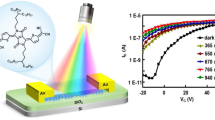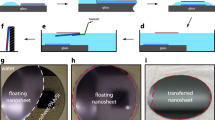Abstract
Organic thin-film transistors are attracting a great deal of attention due to the relatively high field-effect mobility in several organic materials. In these organic semiconductors, however, researchers have not established a reliable method of doping at a very low density level, although this has been crucial for the technological development of inorganic semiconductors. In the field-effect device structures, the conduction channel exists at the interface between organic thin films and SiO2 gate insulators. Here, we discuss a new technique that enables us to control the charge density in the channel by using organosilane self-assembled monolayers (SAMs) on SiO2 gate insulators. SAMs with fluorine and amino groups have been shown to accumulate holes and electrons, respectively, in the transistor channel: these properties are understood in terms of the effects of electric dipoles of the SAMs molecules, and weak charge transfer between organic films and SAMs.
This is a preview of subscription content, access via your institution
Access options
Subscribe to this journal
Receive 12 print issues and online access
$259.00 per year
only $21.58 per issue
Buy this article
- Purchase on Springer Link
- Instant access to full article PDF
Prices may be subject to local taxes which are calculated during checkout





Similar content being viewed by others
References
Dimitrakopoulos, C.D. & Mascaro, D.J. Organic thin-film transistors: A review of recent advances. IBM J. Res. Dev. 45, 11–27 (2001).
Dimitrakopoulos, C.D. & Malenfant, P.R.L. Organic thin film transistors for large area electronics. Adv. Mater. 14, 99–117 (2002).
Klauk, H., Halik, M., Zschieschang, U., Schmid, G. & Radlik, W. High-mobility polymer gate dielectric pentacene thin film transistors. J. Appl. Phys. 92, 5259–5263 (2002).
Kobayashi, S., Takenobu, T., Mori, S., Fujiwara, A. & Iwasa, Y. Fabrication and characterization of C60 thin-film transistors with high field-effect mobility. Appl. Phys. Lett. 82, 4581–4583 (2003).
Malenfant, P.R.L., Dimitrakopoulos, C.D., Gelorme, J.D., Kosbar, L.L. & Graham, T.O. N-type organic thin-film transistor with high field-effect mobility based on a N,N'-dialkyl-3,4,9,10-perylene tetracarboxylic diimide derivative. Appl. Phys. Lett. 80, 2517–2519 (2002).
Klauk, H., Gundluch, D.J., Bonse, M., Kuo, C.-C. & Jackson, N.N. A reduced complexity process for organic thin film transistors. Appl. Phys. Lett. 76, 1692–1694 (2000).
Sze, S.M. in Semiconductor Devices Ch. 5 (Wiley, New York, 1985).
Lin, Y.-Y., Gundlach, D.J., Nelson, S.F. & Jackson, T.N. Stacked pentacene layer organic thin-film transistors with improved characteristics. IEEE Electron Device Lett. 18, 606–608 (1997).
Gundlach, D.J., Nichols, J.A., Zhou, L. & Jackson, T.N. Thin-film transistors based on well-ordered thermally evaporated naphthacene films. Appl. Phys. Lett. 80, 2925–2927 (2002).
Ashkenasy, G., Cahen, D., Cohen, R., Shanzer, A. & Vilan, A. Molecular Engineering of Semiconductor Surfaces and Devices. Acc. Chem. Res. 35, 121–128 (2002).
Ishii, H., Sugiyama, K., Ito, E. & Seki, K. Energy level alignment and interfacial electronic structures at organic/metal and organic/organic interfaces. Adv. Mater. 11, 605–625 (1999).
Mandelis, A. & Christofides, C. Physics, Chemistry and Technology of Solid State Gas Sensor Devices 125 (Wiley, New York, 1993).
Campbell, I.H. et al. Controlling Schottky energy barriers in organic electronic devices using self-assembled monolayers. Phys. Rev. B 54, R14321–R14324 (1996).
Cambell, I.H., Kress, J.D., Martin, R.L. & Smith, D.L. Controlling charge injection in organic electronic devices using self-assembled monolayers. Appl. Phys. Lett. 71, 3528–3530 (1997).
Sugimura, H., Ushiyama, K., Hozumi, A. & Takai, O. Micropatterning of alkyl- and fluoroalkysilane self-assembled monolayers using vacuum ultraviolet light. Langmuir 16, 885–888 (2000).
Dulcey, C.S. et al. Deep UV photochemistry of chemisorbed monolayers: Patterned coplananar molecular assemblies. Science 252, 551–554 (1991).
Stenger, D.A. et al. Assemblies of amino- and perfluorinated alkylsilanes: characterization and geometric definition of mammalian cell adhesion and growth. J. Am. Chem. Soc. 114, 8435–8442 (1992).
Hozumi, A. et al. Amino-terminated self-assembled monolayer on a SiO2 surface formed by chemical vapor deposotion. J. Vac. Sci. Technol. A 19, 1812–1816 (2001).
Kojio, K., Tanaka, K., Takahara, A. & Kajiyama, T. Novel method to prepare organosilane monolayer on solid substrate. Chem. Soc. Jpn 74, 1397–1401 (2001).
Kong, J. & Dai, H. Full and modulated chemical gating of individual carbon nanotubes by organic amine compounds. J. Phys. Chem. 105, 2890–2893 (2001).
Haddon, R.C., Perel, A.S., Morris, R.C., Palstra, T.T.M., & Hebard, A.F. C60 thin-film transistors. Appl. Phys. Lett. 67, 121–123 (1995).
Lee, J., Kim, K., Kim, J.H., Im, S. & Jung, D.-Y. Optimum channel thickness in pentacene-based thin-film transistors. Appl. Phys. Lett. 82, 4169–4171 (2003).
Mushrush, M., Facchetti, A., Lefenfeld, M., Katz, H.E., & Marks T.J. Easily processable phenylene-thiophene-based organic field-effect transistors and solution-fabricated nonvolatile transistor memory elements. J. Am. Chem. Soc. 125, 9414–9423 (2003).
Salleo, A. & Street, R.A. Light-induced bias stress reversal in polyfluorene thin-film transistors. J. Appl. Phys. 94, 471–479 (2003).
Parratt, L.G. Surface studies of solids by total reflection of X-rays. Phys. Rev. 95, 359–369 (1954).
Vidal, B. & Vincent, P. Metallic multilayers for X-rays using classical thin-film theory. Appl. Opt. 23, 1794–1801 (1984).
de Bore, D.K.G. & Leenaers, A.J.G. Probing interface roughness by X-ray scattering. Physica B 221, 18–26 (1996).
Shinha, S.K., Sirota, E.B., Garoff, S & Stanley, H.B. X-Ray and neutron scattering from rough surfaces. Phys. Rev. B 38, 2297–2311 (1988).
Holy, V., Pietsch, U. & Baumbach, T. High-Resolution X-ray Scattering by Thin Films and Multilayers (Springer, Berlin, 1998).
Acknowledgements
This work has been partly supported by a Grant (13440110) from The Ministry of Education, Culture, Sports, Science, and Technology, Japan. The authors thank the staff at the Center for Computational Materials Science at the Insitute for Materials Research, Tohoku University, for computational assistance.
Author information
Authors and Affiliations
Corresponding author
Ethics declarations
Competing interests
The authors declare no competing financial interests.
Supplementary information
Supplementary Information, Fig. S1
Supplementary Information, Fig. S2 (PDF 58 kb)
Rights and permissions
About this article
Cite this article
Kobayashi, S., Nishikawa, T., Takenobu, T. et al. Control of carrier density by self-assembled monolayers in organic field-effect transistors. Nature Mater 3, 317–322 (2004). https://doi.org/10.1038/nmat1105
Received:
Accepted:
Published:
Issue Date:
DOI: https://doi.org/10.1038/nmat1105
This article is cited by
-
Retina-inspired organic neuromorphic vision sensor with polarity modulation for decoding light information
Light: Science & Applications (2023)
-
Spontaneous formation of metastable orientation with well-organized permanent dipole moment in organic glassy films
Nature Materials (2022)
-
Wafer-scale integration of transition metal dichalcogenide field-effect transistors using adhesion lithography
Nature Electronics (2022)
-
Influence of SAM Quality on the Organic Semiconductor Thin Film Gas Sensors
Chemical Research in Chinese Universities (2022)
-
Functionalising the gate dielectric of organic field-effect transistors with self-assembled monolayers: effect of molecular electronic structure on device performance
Applied Physics A (2022)



